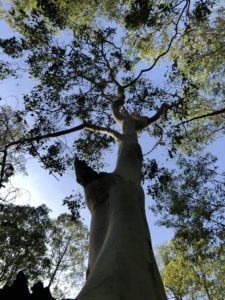Hi Everyone,
This weeks creative meditations article looks to gain a little clarity with regard to the meaning of spirituality which is certainly not the easiest of topics to pin down!
Underneath the article you can find the details of the final meditation class of 2011, which I have entitled “From no self to the Expanded Self”.
Enjoy!
Yours in the spirit of the spiritual,
Toby
Article of the Week:
What Does “Spiritual” Really Mean? (And What it Does Not Mean!)
As a ‘spiritual teacher’ I get to hear and engage in various conversations about spirituality. One thing that often stands out for me is the absence of a clear idea of what we really mean by spiritual. With this in mind, here are five working definitions of what the word spiritual can mean. If you think about your own spiritual path in the context of each of these definitions in turn, you will find that each of them shows you a different aspect of it:
1. The spiritual can refer to the very subtle, formless or causal dimension of existence and experience that lies beyond the coarse physical world of the senses and the subtle energetic world of the mind. It is formless because it is beyond the dimension of physical or mental appearances or ‘forms’. It is called ‘causal’ because it is the dimension from which mental and physical form arise and to which they disappear when they cease. Contact with, experience and exploration of this realm is one of the main aims of meditation.
2. The spiritual is that which is of most fundamental meaning and importance in our life. This is the definition that theologian Paul Tillich uses often. One major reason why the contemplation of death and impermanence is a universal practice in the world’s great wisdom traditions is that doing so helps us to urgently clarify the meaning and purpose of our life in the light of its fleeting and transient nature!
3. Spirituality is the process and discipline of developing a progressively loving and selfless intention. The more genuinely pure and selfless a persons intention, the more spiritual they can be said to be. This process of balanced refinement takes continuous work!
4. Spirituality is the progressive transcendence of the ego, and the opening up to awareness of our expanded or Universal self.
5. Spirituality is the courage and faith to confront and be with the real issues in our life as they arise from moment to moment. To quote Alan Watts in his book ‘The Wisdom of Insecurity’ – “Faith is an unreserved opening to the truth, whatever it may be. Faith has no preconceptions; it is a plunge into the unknown.”
As an adjunct to the above list here are a few of the things that spirituality does NOT mean but is sometimes confused for:
1. Escaping from the ‘real world’ and our real practical/psychological issues by creating our own subtle meditative fantasy world, and imagining that a state of formless meditation is the answer to all our problems.
2. Avoiding appropriate worldly responsibilities and emotional/relational issues we may have by pretending we have more important ‘spiritual’ activities to do.
3. Imagining we have become totally selfless and have transcended our ego whilst our ego runs rampant in a subconscious level. Ken Wilber refers to this as “boomeritis”, Robert Augustus Masters calls it “spiritual bypassing” and Chogyam Trungpa called it “spiritual materialism”. Unfortunately it is still pretty pervasive.
4. Being nice all the time because that what we think being loving and compassionate is all about.
5. Thinking that just ‘being in the present’ means that we don’t need to deal with our past issues or plan for the future.
6. Mistaking trans-rational spiritual states for pre-rational infantile states, similar to point 3. No, children, animals and trees are not enlightened, however they are unconsciously or intuitively in touch with their spiritual natures much of the time. Spirituality is a process of evolution not regression!
© Toby Ouvry 2011, you are welcome to use or share this article, but please cite Toby as the source and include reference to his website www.tobyouvry.com
 Meditation Class 14th December:
Meditation Class 14th December:
From No Self to the Expanded Self: How Buddha’s Teaching on the Emptiness of the Self Can Lead us to an Awakening of Universal Love and Compassion
Facilitator: Toby Ouvry
Date and Time: Wednesday 14thDecember, 7.30-8-30pm
Location: Basic Essence, 501 Bukit Timah Road, 04-04 Cluny Court.
For directions click HERE
Superficially it can see like the Buddhist perspective on “no self” the absence of any kind of permanent of fixed identity of both ourself and all phenomenon can seem a little bit frightening and perhaps even nihilistic. In this one hour meditation class we will be looking at how in reality the realization of no-self awakens within us the capacity to go beyond our ordinary ego boundaries and awaken to our “expanded self” or “great self”, that possesses unconditional love and compassion for all living beings (including ourself!).
This class will be a chance to learn and experience a simple but profound meditation that we can use as a way of liberating our sense of self from limiting patterns and perceptions, and awakening to our true human potential.
On a day to day practical level the understanding that we gain from the meditation can also be applied to help us improve our relationships with others and develop a feeling of pervasive warmth and empathy toward others.
The class will consist of a 30-40 minute practical meditation, and a twenty minute or so talk.
Cost for Class: $25, includes MP3 recording of talk.
To register for class: Contact Basic Essence on 64684991 or email info@tobyouvry.com
 Article of the Week:
Article of the Week:



 Article of the Week:
Article of the Week: Article of the Week:
Article of the Week: Article of the Week:
Article of the Week: Meditation Class 14th December:
Meditation Class 14th December: